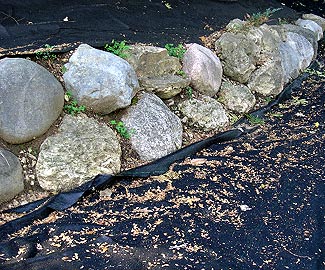RENEGADE GARDENER™
The lone voice of horticultural reason
Don’t ever lay landscape cloth or weed barrier on the ground before planting.
 Insidious, how these product lines have grown. What began years ago as landscape cloth—designed for vertical use behind boulder walls, to keep soil from eroding through the wall—has evolved into any number of “weed barrier” products that homeowners are encouraged to lay flat on the ground before planting trees, shrubs, even perennials.
Insidious, how these product lines have grown. What began years ago as landscape cloth—designed for vertical use behind boulder walls, to keep soil from eroding through the wall—has evolved into any number of “weed barrier” products that homeowners are encouraged to lay flat on the ground before planting trees, shrubs, even perennials.
Homeowners think it’s a great idea: Lay down a weed barrier fabric, and they won’t have any weeds. Except studies have shown that though porous, weed barrier fabrics do not allow water to penetrate the soil as readily as soil without fabric. In heavy rain, a lot of water builds up and runs off, one reason why gardeners who use weed barriers see edges of it glistening in the sunlight so often. More important, weed barrier fabrics decrease the amount of oxygen that is drawn into the soil. All plant roots require oxygen, at various preferred levels (yes, even water plant roots).
It’s a shortcut that harms your soil, and your plants. The worst barrier in the world, of course, is black plastic poli, because it allows NO oxygen or moisture into the soil, except at the base of the plant, where a hole was cut to accommodate planting. The soil dies out all around the plant, meaning no microbe activity (those little microscopic critters need soil that contains air and water and organic material), and the plants don’t bloom as well as they could, don’t grow as fast, and decline prematurely.
But getting back to porous weed barriers … they serve no purpose, except to make you rue the day you put it down on the day you want to move a shrub, plant a new shrub, or plant perennial groundcovers around the shrubs.
The key to growing healthy plants is to duplicate nature. In nature, a tree falls down and over decades it gets sucked back down into the earth, all those nutrients being returned to the ground. In the suburbs, a tree goes down in our yards during a storm, and we call a tree service to remove it. In the woods, trees lose their leaves in the fall so that those leaves can replenish the soil. Meanwhile, we carefully rake every last leaf from our lawns and our gardens in the fall because they smother and kill our lawns over winter, plus we don’t like the look. Then each spring we fertilize the soil like mad.
If you’d like to garden in a way that makes sense, go back to nature. Mulch all your plants with organic matter, placed directly on the soil—a four- to five-inch layer of shredded hardwood is good around trees and shrubs, and a two- to three-inch layer of shredded leaves, dried grass clippings, cocoa bean mulch or the like is good around perennials and annuals. That will block the sunlight most annual weed seeds need to germinate just as effectively as plastic weed barriers. Perennial weeds, like thistles, they’re going to burst up through plastic weed barriers as it weakens in three years, then spread just as quickly as they will in the proper mulch, so you’re not losing anything. Thistles and other tough perennial weeds have to be dug up or sprayed regardless of what you do. And it’s a helluva lot easier to dig up the entire root system of tough perennial weeds popping through organic mulch than it is when a weed barrier fabric is involved.
You WANT these organic mulches to slowly disappear, to break down and replenish the soil around the plants. Mulches around perennials and annuals SHOULD last only one season. You go out and redo the mulch in your flower beds each year, it’s called gardening.
A five-inch layer of shredded hardwood bark around trees and shrubs should last three seasons, depends on the quality, cypress mulch lasts longest but is more expensive. Whichever you use, you just add more as it decays and you see patches of bare soil.
And don’t do this: I’ve seen landscapers lay down weed barrier, cut holes, plant shrubs and perennials, and then top it off with shredded hardwood mulch. Now, the plastic weed barrier stops the decaying mulch from entering the soil! The shredded hardwood ALONE will block the weeds; in this case, the plastic weed barrier is both superfluous and harmful.
You check your mulched beds every few days and pull out the few weeds that make it, pull seven weeds a day in spring and early summer, keep up with your mulching, and after a few seasons you will have very little weed activity. You’re pulling the weeds before they can go to seed, so eventually, no more seeds. Most of the easy-to-pull weeds you spot in summer and fall are probably wind-blown seeds that landed on top of the mulch anyway, and would germinate and grow with or without weed barrier fabric.
Sorry for the length of this, one lousy photo and all. I guess I could have written one sentence to explain this Don’t DO That, instead of the 827 words above: Don’t use weed barrier fabric, because if you start gardening, within five years it will bite you in the ass, and within six years you’ll just wind up ripping it all out.
Don Engebretson
The Renegade Gardener